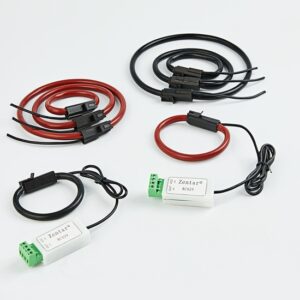The Science Behind Type B Current Transformers
Type B current transformers take center stage in the field of electrical engineering due to their exceptional functionality and design. These residual current transformers are meticulously crafted to monitor and safeguard B-type loads, following the guidelines set by the International Electrotechnical Commission (IEC 60755).
They exhibit a unique capability to measure alternating current (AC), direct current (DC), and pulsating leakage currents. This versatility sets them apart and allows for their use across a wide spectrum of applications, marking them as integral components in contemporary electrical systems.
The Differential Transformers: An Essential Companion
Complementing the functionality of Type B current transformers, differential current transformers have been designed specifically to work in synergy with electronic relays such as the RGU-100B or CBS-400B. These relays attribute the associated trip current, which is often referred to as sensitivity, enabling the transformers to function efficiently.
A standout feature of these transformers is the incorporation of an Ethernet port. This port is designed to foster a seamless connection using Ethernet cable with the relay. The result is a streamlined transmission of readings, operational data, and other critical information on the protected or monitored line, enhancing the overall efficiency and control of the electrical system.
The Broad Applications of Residual Current Transformers
Residual current transformers offer effective protection or monitoring of single-phase or three-phase electrical loads in alternating current systems that have direct current components. Their capability to handle frequencies of up to 1 kHz amplifies their utility across a diverse range of applications.
This includes, but is not limited to, variable speed drives, Uninterruptible Power Supplies (UPS), photovoltaic facilities, electric vehicle charging systems, and active filters. The use of these transformers in such varied scenarios underscores their adaptability and underlines their crucial role in the technology-driven electrical systems of today.
Decoding the Technical Characteristics of Type B Current Transformers
The technical prowess of these transformers is highlighted by their distinctive electrical and mechanical characteristics. Their electrical features include load current connector type. This signifies the type of connector utilized and the format of the electrical signals transmitted.
From a mechanical viewpoint, the transformers are defined by their size and weight. The dimensions, expressed as width x height x depth (in millimeters), and the weight (in kilograms) provide essential data for installation planning, ensuring optimal space utilization.
Regarding environmental characteristics, the transformers are classified according to their thermal class, storage temperature, and working temperature. These considerations are paramount for maintaining the transformers within safe operating parameters, thereby ensuring their long-term performance and durability.
Finally, the specialized technical characteristics of the current sensors, which include sampling frequency, maximum current, and the inner diameter (in millimeters), provide further insight into their capabilities. The current measurement circuit can handle a maximum current of ≤ 750 V ~ and ≤ 750 Vcc, demonstrating their robustness. These transformers meet rigorous electrical safety standards, including IEC 60947-2-M measurement accuracy phase current measurement, and function optimally up to a maximum height of 2000 meters, which offers considerable flexibility in installation options.
Final Remarks
Type B current transformers, with their capability to accurately measure AC, DC, and pulsating leakage currents, provide robust protection and comprehensive monitoring for a plethora of B-type loads. Their technical prowess, coupled with their adaptability, cements their position as indispensable components within modern electrical systems, from variable speed drives to the burgeoning field of electric vehicle charging. A comprehensive understanding of their technical specifications and applications allows for their effective deployment, securing the safety and efficiency of electrical systems in today’s digital age.
Safeguarding the Future with Type B Current Transformers
As we navigate further into the era of digitization and advanced electrical systems, Type B current transformers will continue to play a pivotal role in safeguarding and enhancing the performance of B-type loads. Their unique ability to measure AC, DC, and pulsating leakage currents, along with their robust design and compatibility with relays such as RGU-100B or CBS-400B, make them a versatile tool in the electrical engineering arsenal.
Moreover, their ability to communicate essential operational data via an Ethernet port makes these transformers a critical part of a modern, connected, and intelligent electrical system. Whether it’s about enhancing the performance of variable speed drives, ensuring the seamless operation of Uninterruptible Power Supplies (UPS), or facilitating efficient electric vehicle charging, Type B current transformers are at the forefront, driving safety, efficiency, and innovation.
A Closer Look at Technical Specifications
The technical specifications of these transformers further underline their robustness and adaptability. With load current connector type, they offer a reliable means of transmitting electrical signals. Their size and weight specifications facilitate easy installation and optimal space planning, while their thermal class, storage temperature, and working temperature ensure their performance is uncompromised, regardless of the environmental conditions.
Moreover, the current sensors’ specifications, including sampling frequency, maximum current, and inner diameter, attest to their capability to handle demanding electrical scenarios. With a maximum current of ≤ 750 V ~ and ≤ 750 Vcc, they can tackle a wide range of electrical loads. Their adherence to stringent electrical safety standards, such as IEC 60947-2-M, and their ability to function at a maximum height of 2000 meters, make them suitable for various installation scenarios.
Conclusion: The Vital Role of Type B Current Transformers
In conclusion, Type B current transformers are a testament to the strides made in the field of electrical engineering. Their ability to protect and monitor B-type loads, combined with their versatile application across various modern electrical systems, highlights their importance. Understanding their functionality, technical characteristics, and applications is essential for any electrical engineer or technician aiming to harness their potential fully.
As we move forward, the role of Type B current transformers will only continue to grow, ensuring the safety, efficiency, and performance of our increasingly interconnected and technologically advanced world.






